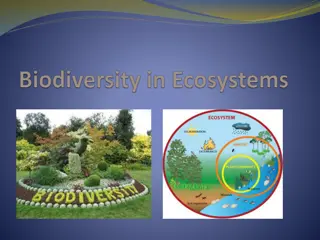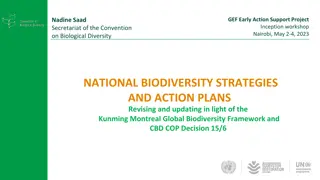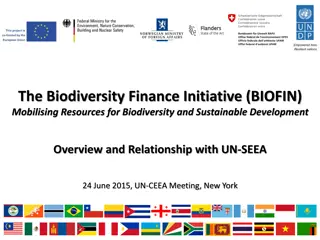Understanding Biodiversity and Classification of Living Organisms
Explore the world of biodiversity and the classification of living organisms in Grade 7 Natural Sciences - Term 1. Learn about the five main kingdoms, Carl Linnaeus' taxonomy work, and the seven-level classification system he introduced. Discover how organisms are grouped and categorized to better study and understand the diversity of life on Earth.
Download Presentation

Please find below an Image/Link to download the presentation.
The content on the website is provided AS IS for your information and personal use only. It may not be sold, licensed, or shared on other websites without obtaining consent from the author. Download presentation by click this link. If you encounter any issues during the download, it is possible that the publisher has removed the file from their server.
E N D
Presentation Transcript
Natural Sciences Grade 7 Term 1: Life and Living Biodiversity (PPT 1)
Topic 2 Biodiversity Classification of Living Organisms Gr 7 Natural Sciences - Term 1, Topic 2
Classification systems We classify objects when we group them with similar objects. This makes it easier for us to make sense of the world around us. We group things all the time: for example, kitchen utensils are grouped into cutlery, plates, bowls and pots. Gr 7 Natural Sciences - Term 1, Topic 2
Classification of Living Organisms Biologists sort living organisms into groups to make it easier to study them. Grouping of living organisms is called biological classification. Living organisms are divided into five main groups called KINGDOMS. These are the bacteria, protists, fungi, plants and animals. Gr 7 Natural Sciences - Term 1, Topic 2
Biodiversity on Earth Each Kingdom is very large and it contains many different types of organisms. 4000 Bacteria 66000 Fungi 150000 Protists 290000 Plants 1200000 Animals Gr 7 Natural Sciences - Term 1, Topic 2
Meet Carl Linnaeus Gr 7 Natural Sciences - Term 1, Topic 2
Who was he? Famous for his work in Taxonomy: the science of identifying, naming and classifying organisms (plants, animals, bacteria, fungi, etc.). He was born in 1707 in R shult, Sweden. He was the eldest of five children. His father, Nils, was a minister and a keen gardener. Gr 7 Natural Sciences - Term 1, Topic 2
Seven Level Classification System He used seven groups or taxonomic levels Kingdom Phylum Class Order Family Genus Species The broadest level The most specific level Gr 7 Natural Sciences - Term 1, Topic 2
Each Kingdom can be divided into smaller groups. Kingdom Gr 7 Natural Sciences - Term 1, Topic 2
Each Kingdom can be divided into smaller groups. Kingdom Phylum Phylum Gr 7 Natural Sciences - Term 1, Topic 2
Each Kingdom can be divided into smaller groups. Kingdom Phylum Phylum Class Class Class Class Gr 7 Natural Sciences - Term 1, Topic 2
Each Kingdom can be divided into smaller groups Kingdom Phylum Phylum Class Class Class Class Family Family Family Family Family Family Family Family Gr 7 Natural Sciences - Term 1, Topic 2
Each Family can further be divided into smaller groups Family Order Order Gr 7 Natural Sciences - Term 1, Topic 2
Each Family can further be divided into smaller groups Family Order Order Genus Genus Genus Genus Gr 7 Natural Sciences - Term 1, Topic 2
Each Family can further be divided into smaller groups Family Order Order Genus Genus Genus Genus Species Species Species Species Species Species Species Species Gr 7 Natural Sciences - Term 1, Topic 2
Classification of the cats and dogs Gr 7 Natural Sciences - Term 1, Topic 2
Classification of the cats and dogs Gr 7 Natural Sciences - Term 1, Topic 2























